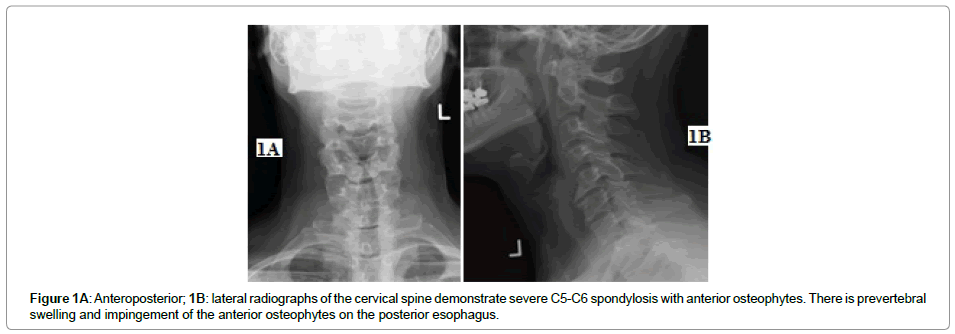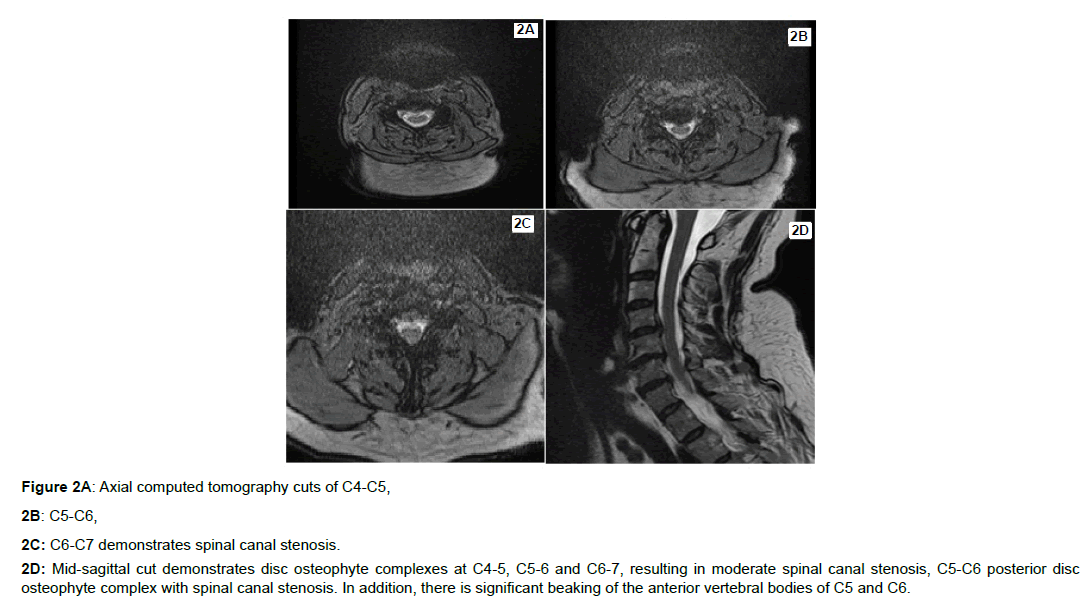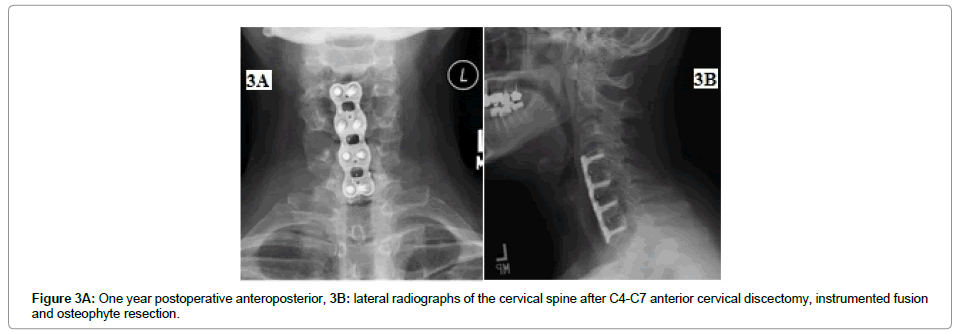Case Report, J Spine Neurosurg Vol: 6 Issue: 4
Esophageal Impingement from Anterior Cervical Osteophytes Associated with Cervical Spondylosis
DeRogatis MJ and Issack PS*
Department of Orthopaedic Surgery, New York-Presbyterian/Lower Manhattan Hospital, New York, USA
*Corresponding Author : Dr. Paul S. Issack
Chief, Divisions of Adult Reconstructive Joint Surgery and Orthopaedic Trauma, New York Downtown Orthopaedic Associates, New York-Presbyterian/Lower Manhattan Hospital, 170 William Street, 8th Floor, New York, NY, 10038, USA
Tel: 212-312-5982
Fax: 212-312-5995
E-mail: PSIssack@aol.com
Received: June 14, 2017 Accepted: July 06, 2017 Published: July 12, 2017
Citation: Issack PS, DeRogatis MJ (2017) Esophageal Impingement from Anterior Cervical Osteophytes Associated with Cervical Spondylosis. J Spine Neurosurg 6:4. doi: 10.4172/2325-9701.1000274
Abstract
We present the case of a 50-year-old lady with progressive neck pain, cervical myelopathy and dysphagia. Cervical spine radiographs and MRI demonstrated a large anterior cervical osteophyte complex impinging on the esophagus as well as cervical stenosis. Surgical treatment with anterior resection of osteophytes and anterior cervical discectomy with fusion relieved the patient’s dysphagia and neck pain. While there are several reports in the literature documenting resection of anterior osteophytes for dysphagia, most of these cases are secondary to DISH and do not present with neurologic symptoms (radiculopathy or myelopathy). To our knowledge, this is the first case presented where the patient presented with both dysphagia and clinical myelopathy, and required both resection of anterior osteophytes and cervical discectomy with fusion.
Keywords: Cervical spondylosis; Radiculopathy; Osteophytes; Myelopathy; Spondylosis
Introduction
Cervical spondylosis commonly presents with neck pain, radiculopathy and/or myelopathy. This chronic degenerative condition can result in stenosis of the central canal with spinal cord compression, and neuroforaminal stenosis with nerve root compression, secondary to posterior or uncovertebral osteophytes, disc degeneration, herniation and disc height loss, facet hypertrophy, ligamentum flavum buckling and hypertrophy, and ossification of the posterior longitudinal ligament (OPLL) [1,2]. Anterior cervical osteophytes may also occur in cervical myelopathy but have rarely been reported to result in esophageal impingement and dysphagia. We present an unusual case of a patient with symptomatic cervical stenosis and anterior cervical osteophytes impinging on the esophagus causing dysphagia. The patient was informed that data concerning the case would be submitted for publication, and the patient agreed.
Case Report
A fifty-year-old female presented with a 2 year period of progressively worsening neck pain, loss of fine motor control in her hands, and dysphagia. Physical therapy and nonsteroidal antiinflammatory medications provided no relief. Her dysphagia was mainly with solid foods. She had increasing difficulty with buttoning shirts. The patient also complained of a general sense of bilateral arm weakness, but denied bowel or bladder dysfunction or gait disturbances. On physical examination, the patient ambulated with a normal gait. Sensation was intact to light touch, and motor strength was 5/5 in all 4 extremities. Upper and lower extremity reflexes were 2+. The patient had a negative Lhermitte’s sign, Spurling’s sign and negative Hoffman’s sign.
Cervical radiographs demonstrated degenerative disc disease with loss of cervical lordosis, and loss of disc height most marked at C5-6 (Figure 1A,B). At the same level, osteophytes projected anteriorly from the inferior endplate of C5 and the superior endplate of C6 impinging on the outline of the esophagus (Figure 1B). Magnetic resonance imaging (MRI) of the cervical spine (Figure 2A-D) demonstrated posterior disc osteophyte complexes at C4-5, C5-6 and C6-7, resulting in moderate spinal canal stenosis. Facet hypertrophy caused additional posterior compression at C6-7.
Figure 2A: Axial computed tomography cuts of C4-C5,
2B: C5-C6,
2C: C6-C7 demonstrates spinal canal stenosis.
2D: Mid-sagittal cut demonstrates disc osteophyte complexes at C4-5, C5-6 and C6-7, resulting in moderate spinal canal stenosis, C5-C6 posterior disc osteophyte complex with spinal canal stenosis. In addition, there is significant beaking of the anterior vertebral bodies of C5 and C6.
Given her current symptoms and findings, a C4 to C7 anterior cervical discectomy and fusion with allograft was performed. The patient’s head was supported using Gardner-Wells tongs with 7 pounds of cervical traction. The arms were taped distally to improve exposure, and neuromonitoring leads were placed to assess spinal cord motor pathways intraoperatively. The patient’s neck was prepped and draped using standard sterile technique and the left hip was prepped for iliac crest bone marrow aspiration. An iliac crest bone marrow aspirate was harvested and mixed with commercial allograft (Stryker Vitoss©, Kalamazoo, MI). A standard anterior left-sided approach was utilized to access the anterior vertebral bodies from C4 to C7. Location was confirmed by intraoperative radiographic imaging using a spinal needle marker in the disc space. The anterior osteophytes of C5 and C6 were removed using a rongeur followed by a high speed burr to smooth and level the anterior surface. Standard discectomies and endplate preparation were then performed. Cervical interbody fusion was performed using appropriately sized PEEK cages and bone graft insertion at C4-C5, C5-6, and C6-C7. An anterior cervical plate was affixed to the C4, C5, C6, and C7 vertebral bodies with locking screws. Intraoperative x-rays demonstrated good placement of instrumentation. The patient’s post-operative course was unremarkable. At her two week follow-up, she confirmed resolution of her dysphagia, and neck pain. At her one year follow-up, she had no pain or dysphagia and good strength in both arms. One year postoperative cervical spine radiographs show good placement of instrumentation and no anterior osteophyte formation (Figure 3A,B).
Discussion
Dysphagia due to anterior cervical spondylosis with myelopathy or radiculopathy has rarely been reported. There are, however, several reports describing dysphagia resulting from esophageal compression from anterior osteophytes in diffuse idiopathic skeletal hyperostosis (DISH), posttraumatic osteophytosis, and cervical spondylosis [3-7]. In all of these reports, osteophyte resection was performed through either an anterolateral approach or a transoral approach without fusion [3-7]. Most reported causes of dysphagia secondary to esophageal compression from anterior osteophytes are associated with DISH. This condition develops from flowing ossification of the anterolateral aspects of 4 contiguous vertebrae, with preservation of intervertebral disc height [8]. Thus, in the majority of cases of dysphagia associated with DISH, there are no neurologic symptoms, and cervical discectomy and fusion is not performed [3-7].
There are few case series which have evaluated the outcomes of surgical resection of anterior osteophytes for dysphagia. Carlson and colleagues reviewed 9 patients who underwent anterior osteophyte resection for dysphagia. The osteophytosis was associated with DISH in 6 patients, was posttraumatic in 2 patients, and was associated with spondylosis in one patient. All had significant improvement in dysphagia after osteophyte resection [3]. Oppenlander and colleagues observed similar results with relief of dysphagia after surgical resection of anterior impinging osteophytes in 9 patients. The underlying diagnosis was DISH in 5 patients, spondylosis in 4 patients and adjacent segment degeneration in 2 patients. No patient underwent fusion in addition to anterior osteophyte resection [6].
Miyamoto et al. followed 7 patients with a diagnosis of DISH, who underwent anterior osteophyte resection for dysphagia. At a 9 year mean follow-up, 2 patients had recurrence of osteophytes necessitating repeat surgical resection. Both underwent resection at 11 years follow-up, one undergoing osteophyte resection alone, and the other undergoing C2-4 anterior cervical discectomy and fusion for neurologic symptoms [5]. Von der Hoeh and colleagues reported on a 7 year follow-up of 6 patients with DISH and dysphagia resulting from anterior osteophytes. They performed osteophyte resection and discectomy and fusion in all patients. All patients had relief of dysphagia with no recurrence of osteophytes in the follow-up period. In their discussion, the authors cited the Miyamoto study and the recurrence of osteophytes seen in that series as an indication to perform fusion in addition to osteophyte resection [5]. While the main indication for cervical fusion in this study was non-neurologic (to prevent instability and the potential for osteophyte recurrence), in one case the fusion was extended to 3 levels to include a spondylotic segment contributing to radiculopathic symptoms [9].
In our case, the primary reason for fusion was the patient’s clinical myelopathy and radiographic evidence of cervical stenosis. The case is therefore unique in the combination of neurologic symptoms as well as dysphagia necessitating anterior cervical fusion in addition to osteophyte resection. One explanation for the rarity of these combined esophageal and neurologic symptoms may have to do with the rate of development of spinal cord or nerve root compression in cervical spondylosis. If patients with DISH, who have a propensity for anterior ossification, are excluded, those with cervical spondylosis likely develop degenerative changes that are more likely to cause impingement posterior to the vertebral body, than anterior. Furthermore, the spinal cord and nerve roots are less forgiving to compression than the esophagus, and therefore more severe spondylosis, with larger anterior and posterior osteophytes are required to create dysphagia. However, in most patients, the cervical radiculopathy/myelopathy is usually addressed before esophageal symptoms develop. In anterior cervical discectomy and fusion, these anterior osteophytes are routinely removed to allow for good anterior plate seating, and so they are never able to reach the dimensions necessary to create dysphagia.
References
- Emery SE (2001) Cervical spondylotic myelopathy: diagnosis and treatment. J Am Acad Orthop Surg 9: 376-388.
- Lebl DR, Bono CM (2015) Update on the Diagnosis and Management of Cervical Spondylotic Myelopathy. J Am Acad Orthop Surg 23: 648-660.
- Carlson ML, Archibald DJ, Graner DE, Kasperbauer JL (2011) Surgical management of dysphagia and airway obstruction in patients with prominent ventral cervical osteophytes. Dysphagia 26: 34-40.
- Erdur O, Tasli H, Polat B, Sofiyev F, Tosun F, et al. (2017) Surgical Management of Dysphagia Due to Anterior Cervical Osteophytes. J Craniofac Surg 28: e80-e84.
- Miyamoto K, Sugiyama S, Hosoe H, Iinuma N, Suzuki Y, et al. (2009) Postsurgical recurrence of osteophytes causing dysphagia in patients with diffuse idiopathic skeletal hyperostosis. Eur Spine J 18: 1652-1658.
- Oppenlander ME, Orringer DA, La Marca F, McGillicuddy JE, Sullivan SE, et al. (2009) Dysphagia due to anterior cervical hyperosteophytosis. Surg Neurol Int 72: 266-270.
- Seidler TO, Perez Alvarez JC, Wonneberger K, Hacki T (2009) Dysphagia caused by ventral osteophytes of the cervical spine: clinical and radiographic findings. Eur Arch Otorhinolaryngol 266: 285-291.
- Resnick D, Niwayama G (1976) Radiographic and pathologic features of spinal involvement in diffuse idiopathic skeletal hyperostosis (DISH). Radiology 119: 559-568.
- von der Hoeh NH, Voelker A, Jarvers JS, Gulow J, Heyde CE (2015) Results after the surgical treatment of anterior cervical hyperostosis causing dysphagia. Eur Spine J 4: S489-S493.
 Spanish
Spanish  Chinese
Chinese  Russian
Russian  German
German  French
French  Japanese
Japanese  Portuguese
Portuguese  Hindi
Hindi 



